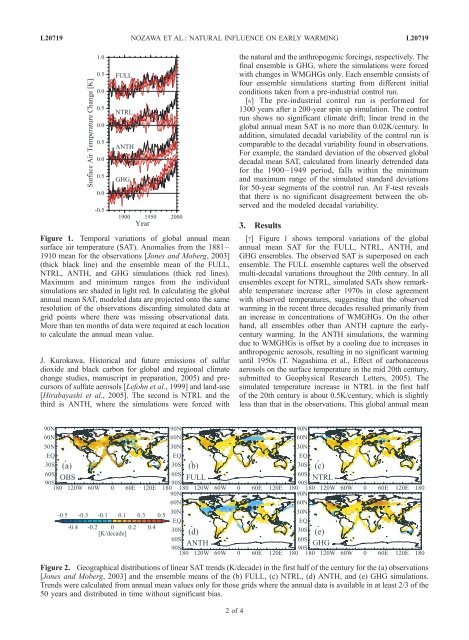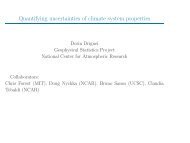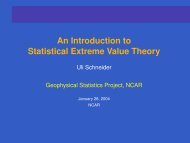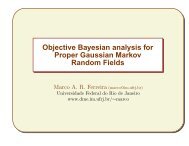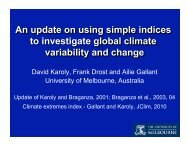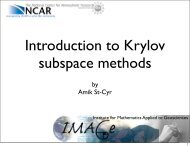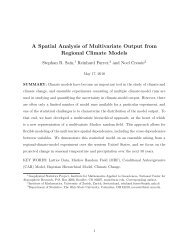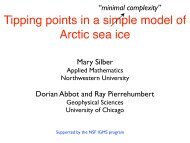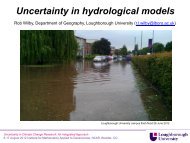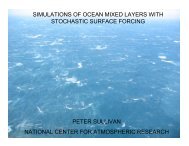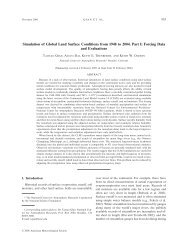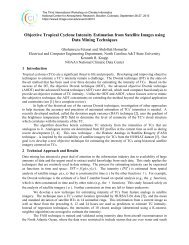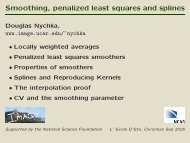L20719 NOZAWA ET AL.: NATURAL INFLUENCE ON EARLY WARMING L20719the <str<strong>on</strong>g>natural</str<strong>on</strong>g> and the anthropogenic forcings, respectively. Thefinal ensemble is GHG, where the simulati<strong>on</strong>s were forcedwith changes in WMGHGs <strong>on</strong>ly. Each ensemble c<strong>on</strong>sists offour ensemble simulati<strong>on</strong>s starting from different initialc<strong>on</strong>diti<strong>on</strong>s taken from a pre-industrial c<strong>on</strong>trol run.[6] The pre-industrial c<strong>on</strong>trol run is performed for1300 years after a 200-year spin up simulati<strong>on</strong>. The c<strong>on</strong>trolrun shows no significant climate drift; linear trend in theglobal annual mean SAT is no more than 0.02K/century. Inadditi<strong>on</strong>, simulated decadal variability of the c<strong>on</strong>trol run iscomparable to the decadal variability found in observati<strong>on</strong>s.For example, the standard deviati<strong>on</strong> of the observed globaldecadal mean SAT, calculated from linearly detrended datafor the 1900–1949 period, falls within the minimumand maximum range of the simulated standard deviati<strong>on</strong>sfor 50-year segments of the c<strong>on</strong>trol run. An F-test revealsthat there is no significant disagreement between the observedand the modeled decadal variability.Figure 1. Temporal variati<strong>on</strong>s of global annual mean<strong>surface</strong> <strong>air</strong> <strong>temperature</strong> (SAT). Anomalies from the 1881–1910 mean for the observati<strong>on</strong>s [J<strong>on</strong>es and Moberg, 2003](thick black line) and the ensemble mean of the FULL,NTRL, ANTH, and GHG simulati<strong>on</strong>s (thick red lines).Maximum and minimum ranges from the individualsimulati<strong>on</strong>s are shaded in light red. In calculating the globalannual mean SAT, modeled data are projected <strong>on</strong>to the sameresoluti<strong>on</strong> of the observati<strong>on</strong>s discarding simulated data atgrid points where there was missing observati<strong>on</strong>al data.More than ten m<strong>on</strong>ths of data were required at each locati<strong>on</strong>to calculate the annual mean value.J. Kurokawa, Historical and future emissi<strong>on</strong>s of sulfurdioxide and black carb<strong>on</strong> for global and regi<strong>on</strong>al climatechange studies, manuscript in preparati<strong>on</strong>, 2005) and precursorsof sulfate aerosols [Lefohn et al., 1999] and land-use[Hirabayashi et al., 2005]. The sec<strong>on</strong>d is NTRL and thethird is ANTH, where the simulati<strong>on</strong>s were forced with3. Results[7] Figure 1 shows temporal variati<strong>on</strong>s of the globalannual mean SAT for the FULL, NTRL, ANTH, andGHG ensembles. The observed SAT is superposed <strong>on</strong> eachensemble. The FULL ensemble captures well the observedmulti-decadal variati<strong>on</strong>s throughout the 20th century. In allensembles except for NTRL, simulated SATs show remarkable<strong>temperature</strong> increase after 1970s in close agreementwith observed <strong>temperature</strong>s, suggesting that the observedwarming in the recent three decades resulted primarily froman increase in c<strong>on</strong>centrati<strong>on</strong>s of WMGHGs. On the otherhand, all ensembles other than ANTH capture the earlycenturywarming. In the ANTH simulati<strong>on</strong>s, the warmingdue to WMGHGs is offset by a cooling due to increases inanthropogenic aerosols, resulting in no significant warminguntil 1950s (T. Nagashima et al., Effect of carb<strong>on</strong>aceousaerosols <strong>on</strong> the <strong>surface</strong> <strong>temperature</strong> in the mid 20th century,submitted to Geophysical Research Letters, 2005). Thesimulated <strong>temperature</strong> increase in NTRL in the first halfof the 20th century is about 0.5K/century, which is slightlyless than that in the observati<strong>on</strong>s. This global annual meanFigure 2. Geographical distributi<strong>on</strong>s of linear SAT trends (K/decade) in the first half of the century for the (a) observati<strong>on</strong>s[J<strong>on</strong>es and Moberg, 2003] and the ensemble means of the (b) FULL, (c) NTRL, (d) ANTH, and (e) GHG simulati<strong>on</strong>s.Trends were calculated from annual mean values <strong>on</strong>ly for those grids where the annual data is available in at least 2/3 of the50 years and distributed in time without significant bias.2of4
L20719 NOZAWA ET AL.: NATURAL INFLUENCE ON EARLY WARMING L20719Figure 3. Best-estimated (a, b) signal amplitudes and (c, d)linear trends (K/century) with 5–95% uncertainty ranges forthe 50-year segment from 1900 to 1949 for the GHG,ANTH-GHG (anthropogenic signal other than WMGHGs)(Figures 3a and 3c), and the NTRL analysis and for theANTH and NTRL analysis (Figures 3b and 3d). The orangeerror bar with an asterisk, green error bar with a diam<strong>on</strong>d,light green error bar with a cross, and blue error bar with atriangle indicates GHG, ANTH-GHG, ANTH, and NTRL,respectively. Also shown in Figures 3c and 3d are the totalrec<strong>on</strong>structed trend from the regressi<strong>on</strong> model (red error barwith a plus) and the observed (solid error bar with a square)trend. Error bars denote 5–95% uncertainty ranges.SAT trend in NTRL is larger than that of Stott et al. [2000]and T02 (0.3K/century) for their simulati<strong>on</strong>s with <str<strong>on</strong>g>natural</str<strong>on</strong>g>forcings <strong>on</strong>ly, although we use identical <str<strong>on</strong>g>natural</str<strong>on</strong>g> forcingdatasets to the <strong>on</strong>es they used. The trend of the globalannual mean SAT in GHG is nearly equal to that in NTRL;therefore, without further investigati<strong>on</strong>, we cannot c<strong>on</strong>cludewhich factors are the main c<strong>on</strong>tributors to the observedearly warming.[8] Geographical distributi<strong>on</strong>s of linear SAT trends forthe first half of the century are shown in Figure 2 for theobservati<strong>on</strong>s and the ensemble mean of each ensemble. Thetrend patterns in NTRL as well as in FULL (Figures 2band 2c) compare quite favorably with the trend patterndrawn from the observati<strong>on</strong>s (Figure 2a). In the ANTHsimulati<strong>on</strong>s, <strong>on</strong> the other hand, the indirect effect ofanthropogenic aerosols introduces cooling trends in theNorth America and the Northern Atlantic (Figure 2d),where the observed warming was largest in this period(1900–1949) (Figure 2a). The trend pattern in GHG(Figure 2e) looks less similar to the trends in the observati<strong>on</strong>sthan do the trends in NTRL.[9] To clarify the relative importance of the effect ofWMGHGs and <str<strong>on</strong>g>natural</str<strong>on</strong>g> <str<strong>on</strong>g>influence</str<strong>on</strong>g>s <strong>on</strong> the warming in theearly 20th century, an optimal detecti<strong>on</strong> method usingtotal least squares regressi<strong>on</strong> (TLS) [Allen and Stott,2003] was applied to the simulated and observed SAT.In c<strong>on</strong>trast to ordinary least squares regressi<strong>on</strong> (OLS), aswas used in many previous studies (e.g., T02), TLS takesinto account sampling uncertainty in the model resp<strong>on</strong>seswhen estimating the signal amplitudes, and gives anunbiased regressi<strong>on</strong> coefficient. Similar to the analysisof T02, we regress the observed spatio-temporal variati<strong>on</strong>s<strong>on</strong>to the three model-derived resp<strong>on</strong>se patterns fromGHG, ANTH, and NTRL to estimate the signal amplitudesfor GHG, ANTH-GHG (i.e., the <strong>temperature</strong> resp<strong>on</strong>seto all the anthropogenic <str<strong>on</strong>g>influence</str<strong>on</strong>g>s exceptWMGHGs) and NTRL effects. The signal amplitude forANTH-GHG is computed via a linear transformati<strong>on</strong> fromthe GHG and ANTH resp<strong>on</strong>ses (see T02 for moredetails). Following the approach of Stott et al. [2001]the observed and simulated SATs in the early 20thcentury (1900–1949) were averaged decadally, expressedas anomalies with respect to the same period, and filteredby projecting <strong>on</strong>to T4 spherical harm<strong>on</strong>ics. We calculatethe signal amplitudes by estimating covariance matrices,for optimizati<strong>on</strong>, from intra-ensemble spread of theensembles using a truncati<strong>on</strong> of 10 EOFs. Applying theresidual test of Allen and Tett [1999], we found thatthe residual in the regressi<strong>on</strong> was c<strong>on</strong>sistent with c<strong>on</strong>trolvariability. The uncertainty <strong>on</strong> the amplitudes was estimatedfrom our 1300-year c<strong>on</strong>trol simulati<strong>on</strong>.[10] The estimated signal amplitudes and uncertaintyranges (Figure 3a) indicate that, unlike with T02, <strong>on</strong>ly the<str<strong>on</strong>g>natural</str<strong>on</strong>g> c<strong>on</strong>tributi<strong>on</strong> is detectable (i.e., <strong>on</strong>ly the uncertaintyrange for NTRL is entirely positive), and since the uncertaintyrange includes unity, the signal amplitude is c<strong>on</strong>sistentwith the amplitude of the signal in observati<strong>on</strong>s. Itshould also be noted that the detecti<strong>on</strong> of the NTRL signaland its c<strong>on</strong>sistency with the observati<strong>on</strong>s is independent ofthe number of EOFs retained in the analysis (not shown).Therefore the detected <str<strong>on</strong>g>natural</str<strong>on</strong>g> c<strong>on</strong>tributi<strong>on</strong> is robust. Thetwo anthropogenic signals, <strong>on</strong> the other hand, have largeuncertainty and are not detectable. Again this result isindependent of number of EOFs retained in the analysis(not shown). To make a direct comparis<strong>on</strong> with the analysisof T02, we repeated our analysis using OLS. We found thatthe best-estimated signal amplitudes are not largely differentfrom those shown in Figure 3a (calculated with TLS).However, since OLS assume no sampling uncertainty inthe model resp<strong>on</strong>ses, the estimated uncertainty limits aresmaller with OLS than those with TLS (not shown). Itshould be noted that, unlike with T02, the two anthropogenicsignals have large uncertainty and are not detectedeven in our OLS analysis.[11] Figure 3c shows best-estimated linear trend for theearly half of the century. The total trend shows much betteragreement with the observati<strong>on</strong>s than that in T02. Note thatthe best-estimated trends in Figure 3c are also not largelydifferent from those with OLS. The <str<strong>on</strong>g>natural</str<strong>on</strong>g> forcing causes awarming trend of 0.6K/century, which is about <strong>on</strong>e half ofthe observed trend. This is c<strong>on</strong>sistent with the global annualmean SAT anomalies simulated in NTRL (Figure 1). Theresidual of the observed trend (0.4K/century) may becaused by the combined anthropogenic forcings, primarilyby the WMGHGs. However, the two anthropogenic signalsare highly uncertain and are not detected. Therefore thecause of the residual trend is not obvious.[12] The robustness of the NTRL signal is tested byregressing the observati<strong>on</strong>s <strong>on</strong>to the two simulatedresp<strong>on</strong>ses from ANTH and NTRL (Figures 3b and 3d).Again, <strong>on</strong>ly the <str<strong>on</strong>g>natural</str<strong>on</strong>g> c<strong>on</strong>tributi<strong>on</strong> is detected while thenet anthropogenic signal is highly uncertain and is notdetected. This c<strong>on</strong>firms the significance of the <str<strong>on</strong>g>natural</str<strong>on</strong>g>c<strong>on</strong>tributi<strong>on</strong>s to the early 20th century warming.4. C<strong>on</strong>cluding Remarks[13] Surface <strong>air</strong> <strong>temperature</strong> changes simulated by aglobal coupled climate model with different external forcingsare investigated to detect the observed climate changesignals in the early 20th century. Unlike with several3of4


